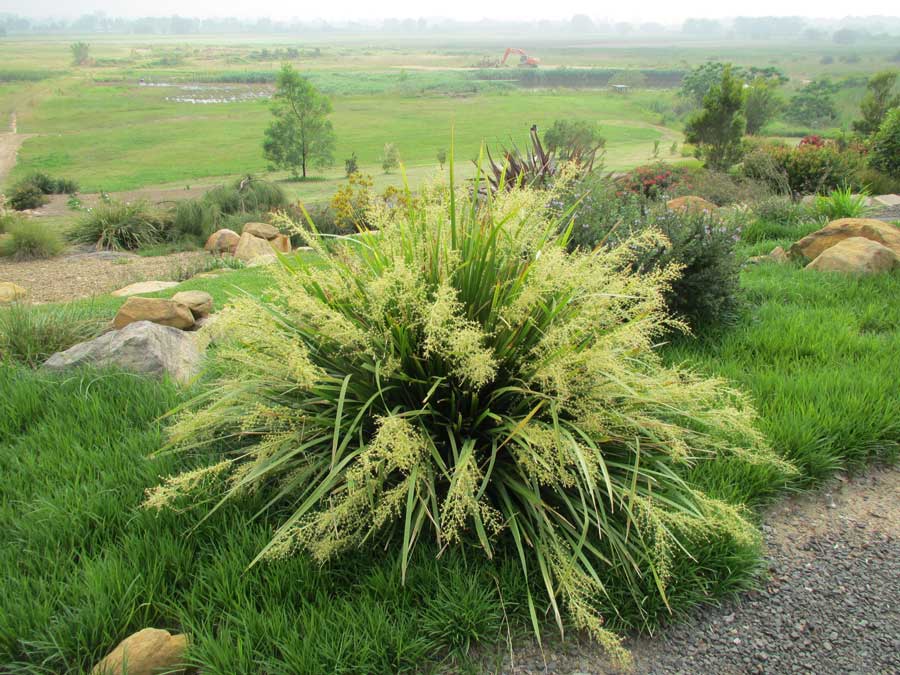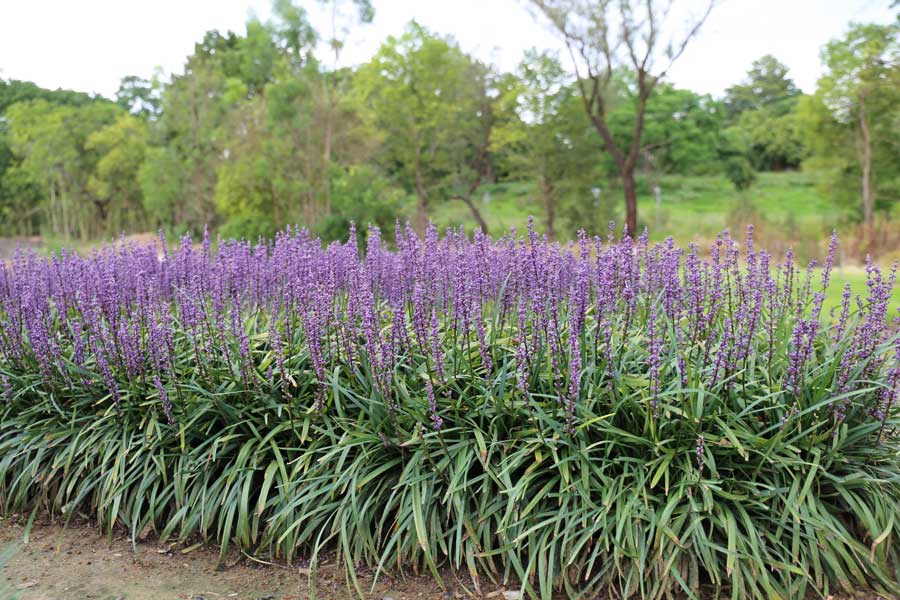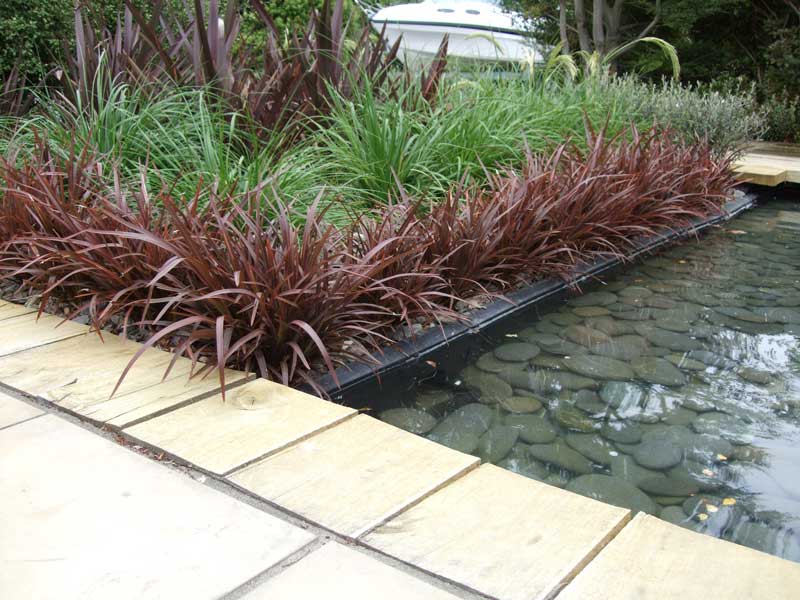Creating a visually striking garden or interior space can be achieved by strategically using strappy leaf plants to draw attention and create dramatic focal points. This phenomenon revolves around leveraging the unique qualities of these plants, characterised by their long, slender foliage, to enhance the aesthetic appeal and structure of your environment.
In this guide, we’ll explore various tips and tricks for effectively incorporating strappy leaf plants into your design, ensuring that they stand out and captivate the viewer. We’ll also cover some of the most spectacular strappy plants that are best suited for this function.

The variegated foliage on this strappy plant really pops against the timber background. Banana Split™ Dietes grandiflora‘DI3’ PBR. https://www.ozbreed.com.au/plant-ranges/strappy-leaf-plants/banana-split/
Strategic Placement
One of the most crucial aspects of using strappy leaf plants to create focal points is their placement. Positioning these plants near entrances and pathways can guide visitors’ eyes and make a strong first impression. Similarly, using them in corners or at the edges of garden beds can help frame and define spaces, adding structure to your design.
The Difference Between Using Strappy Leaf Plants Sparingly for Focal Points and Mass Planting
When it comes to creating focal points with strappy leaf plants, the strategy you choose can significantly impact the overall aesthetic and effectiveness of your design. Two primary approaches are using these plants sparingly to create distinct focal points or employing mass planting to draw the eye. Here’s a detailed look at how these strategies differ:
Using Strappy Leaf Plants Sparingly
Using strappy leaf plants sparingly focuses on showcasing the unique qualities of individual plants or small groups. Here’s how this approach works:
- Distinctiveness: By placing strappy leaf plants in key locations, such as entrances, pathways, or corners, you highlight their architectural form and striking foliage. Each plant becomes a standout feature, drawing attention due to its uniqueness.
- Precision: This approach requires careful consideration of placement. The goal is to create visual interest through strategic positioning, ensuring that each plant serves as a carefully curated element within the landscape.
- Contrast: When used sparingly, strappy leaf plants can be paired with contrasting elements, such as different textures or colours, to enhance their visual impact. This contrast ensures that they remain the focal point within a given space.
In essence, using strappy leaf plants sparingly is about creating specific, high-impact moments within your design. Each plant stands out distinctly, serving as a highlighted feature that draws the viewer’s eye due to its deliberate placement and unique characteristics.

The large lomandra in flower pops against the shorter strappy liriopes, which blend into the background. Katie Belles™ Lomandra hystrix‘LHBYF’ PBR. https://www.ozbreed.com.au/plant-ranges/strappy-leaf-plants/katie-belles-lomandra/
Mass Planting with Strappy Leaf Plants
In contrast, mass planting involves using a larger number of strappy leaf plants to create a cohesive visual effect. They can lead the eye throughout the landscape, can create a cohesive background against which other plants can pop, and they can create a focal point in larger landscapes. Here’s how this approach differs from using individual plants for a focal point:
- Unity and Cohesion: Mass planting produces a unified look by grouping numerous strappy leaf plants together. This approach leverages repetition and scale to create a visually compelling swathe of foliage.
- Impact Through Quantity: The collective presence of many strappy leaf plants can create a powerful visual statement. The sheer number of plants can dominate an area, making it a focal point through volume and consistency.
- Flow and Movement: Mass planting can guide the viewer’s eye across a landscape. By planting in large groups or patterns, you can create a sense of flow and movement that leads the eye naturally from one part of the garden to another.
Mass planting is about creating a broad, impactful visual effect that relies on the repetition and scale of strappy leaf plants. This method transforms an area into a focal point through the uniformity and collective presence of the plants, resulting in a more immersive and continuous visual experience.

The purple flowers and green foliage draw attention to this mass planted bed. Amethyst™ Liriope muscari‘LIRTP’ PBR. https://www.ozbreed.com.au/plant-ranges/strappy-leaf-plants/amethyst-liriope/
Contrast and Complement
Contrast plays a vital role in making strappy leaf plants stand out. Combining these plants with contrasting colours, such as vibrant greens against dark mulch or brightly coloured flowers, can enhance their visibility. Pairing them with plants of differing textures, such as broad-leafed shrubs or finely textured ground covers, creates a balanced composition that draws the eye.
Height and Layering
Adding vertical interest and depth to your design can be achieved through careful attention to height and layering. Use taller varieties of strappy leaf plants to add vertical emphasis, especially in areas dominated by low-growing plants. Arranging plants in layers, with shorter species in front and taller ones behind, can create depth and dimension that makes your design more engaging.
Symmetry and Asymmetry
Your design can take on different aesthetics based on symmetrical or asymmetrical arrangements. Creating formal, balanced designs with symmetrical planting on either side of a path or feature can lend a structured feel to your space. Alternatively, opting for a more natural look with asymmetrical placements allows you to weave these plants into mixed borders for a less rigid appearance.
Seasonal Interest
Some gardens look better during some seasons than others. Usually winter is a bit more boring in some gardens, especially those with deciduous trees and shrubs. Strappy plants are generally evergreen, so they can provide colour and biodiversity resources the whole year around.

The red foliage of this dianella provides colour all year round. Blaze™ Dianella tasmanica‘NPW2’ PBR. https://www.ozbreed.com.au/plant-ranges/strappy-leaf-plants/blaze-dianella/
Containers and Raised Beds
Elevating strappy leaf plants can further enhance their prominence. Decorative pots and containers not only make these plants stand out but also allow for flexible positioning. Planting them in raised beds increases their visibility and facilitates better viewing angles.
Lighting
Effective lighting can dramatically enhance the visual impact of strappy leaf plants. Installing uplighting highlights the architectural form of these plants at night, adding a dramatic effect. Positioning lights behind the plants to create silhouettes can emphasise their unique shape and structure, making them a focal point even after dark. Alternatively, you can have lights at the base facing up, making strappy plants appear more dramatic.
Maintenance and Care
Regular maintenance is key to ensuring that your focal points remain attractive and healthy. Remove dead foliage at the base of plants, and prune dead heads (spent flower stalks). Every few years, you may opt for pruning the plants close to the ground to give them a new lease on life.
Monitoring for pests and diseases and addressing issues promptly prevents damage that could detract from their visual appeal.
Water Features
Incorporating water elements can amplify the impact of strappy leaf plants. Placing these plants near water features like ponds or fountains allows the reflective quality of the water to enhance their beauty. Choosing varieties that thrive in moist conditions if planting near water features ensures their health and vibrancy, and opt for chlorine or salt-resistant plants near pools.

This border of red NZ flax is striking near green foliage and water. Sweet Mist® Phormium tenax‘PH0S2’ PBR. https://www.ozbreed.com.au/plant-ranges/strappy-leaf-plants/sweet-mist-phormium/
Group Planting and Geometric Patterns
Using groups of the same varieties to create a mass planting effect can be more striking than individual plants when arranged in geometric patterns such as circles, squares, or spirals.
Companion Plants and Sculptural Elements
Complement and enhance strappy leaf plants with companion plants and sculptural elements. Selecting companions that enhance the aesthetic appeal without overshadowing them creates a harmonious design. Integrating sculptures or garden ornaments nearby adds interest and creates a cohesive look.
Movement, Wind, and Colourful Foliage
Incorporate elements of movement and colour for dynamic designs. Positioning plants where they can catch the breeze allows their leaves to sway, adding movement to the garden. Considering plants with variegated or colourful foliage provides visual interest beyond just form and texture.
Best Strappy Plants for Dramatic Focal Points
Lomandra: https://www.ozbreed.com.au/plant-ranges/strappy-leaf-plants/#Lomandra
Dianella: https://www.ozbreed.com.au/plant-ranges/strappy-leaf-plants/#Dianella
Native grasses: https://www.ozbreed.com.au/plant-ranges/native-grasses/
Phormium: https://www.ozbreed.com.au/plant-ranges/strappy-leaf-plants/#Other
Dietes: https://www.ozbreed.com.au/plant-ranges/strappy-leaf-plants/#Diete
Liriope: https://www.ozbreed.com.au/plant-ranges/strappy-leaf-plants/#Liriope
Agapanthus: https://www.ozbreed.com.au/plant-ranges/hardy-exotic-range/#Agapanthu
Conclusion
By following these tips and tricks, you can effectively use strappy leaf plants to create captivating focal points that enhance the beauty and structure of your garden or interior space. Whether you’re aiming for a formal, balanced design or a more natural, asymmetrical look, these strategies will help you achieve dramatic and engaging results.
